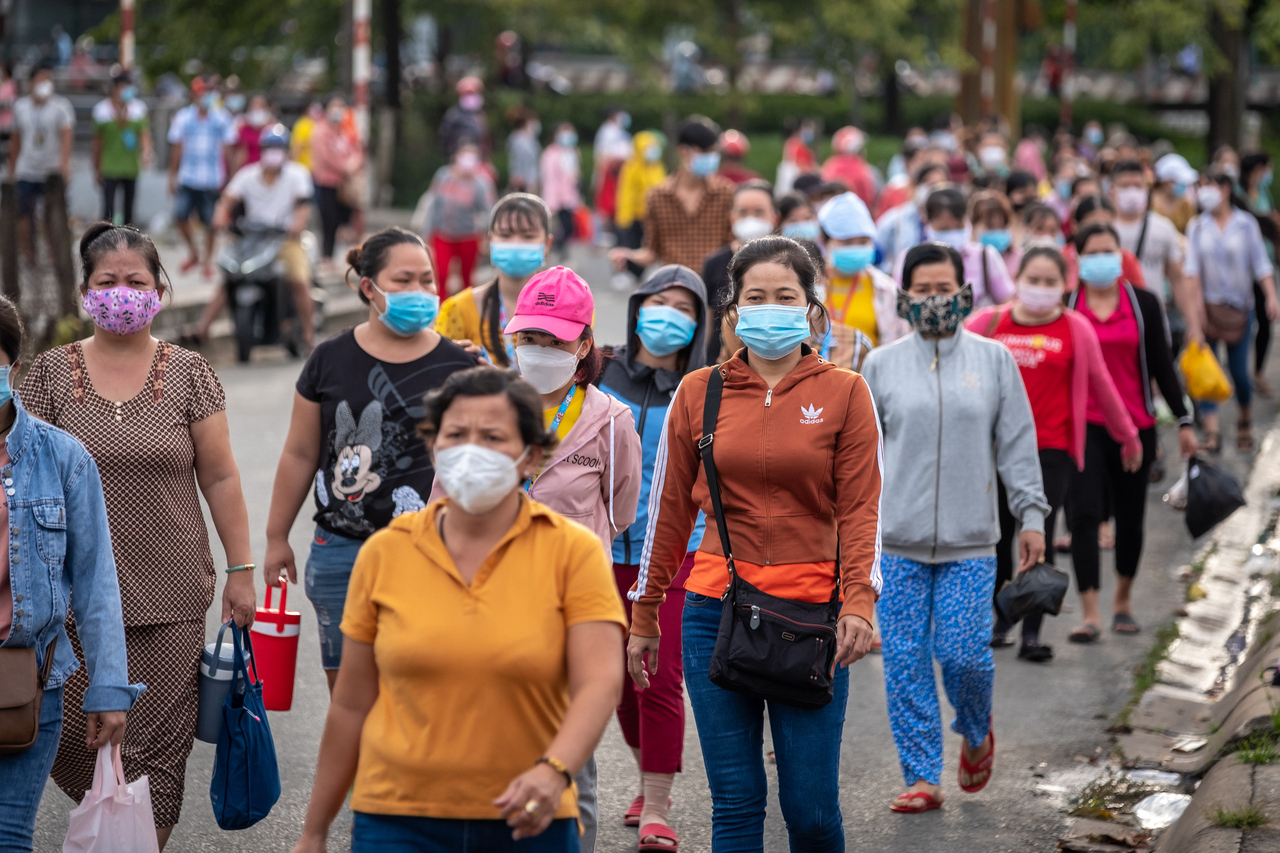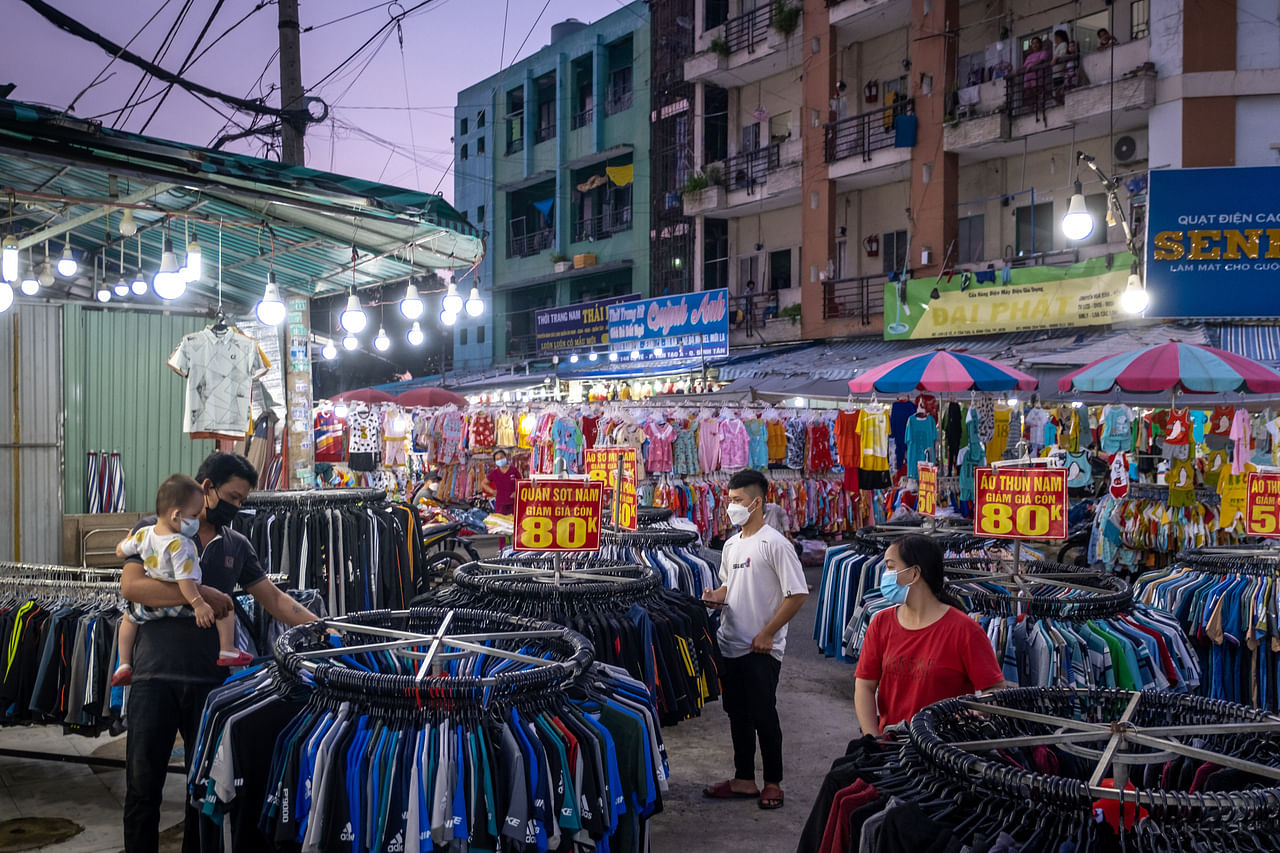As holidays near, bosses try to coax Vietnam's workers back to factories
Sign up now: Get insights on Asia's fast-moving developments

Employees leaving a factory after a shift in Ho Chi Minh City on Oct 25, 2021.
PHOTO: NYTIMES
Follow topic:
HO CHI MINH CITY (NYTIMES) - Ms Thu Trang travelled to Ho Chi Minh City in 2019, ecstatic to get a job at a factory. She worked eight-hour shifts and was guaranteed overtime pay, and the wages were nearly triple what she had made as a farmer back home.
But during a Covid-19 outbreak this summer, the factory where she worked making Adidas, Converse and New Balance shoes virtually shut down. She and her co-workers were forced to live in a cramped apartment for nearly three months, subsisting on a diet of rice and soya sauce.
In October, when restrictions loosened as global supply chain issues surged, Ms Thu Trang decided she would pack up and return to her home province, Tra Vinh. Her manager promised her higher wages, but she did not bother to find out how much.
"Even if the company doubles or triples our wages, I insist on moving back home," said Ms Thu Trang, who asked to be identified only by her first name because she feared retribution from her company and the government. "Ho Chi Minh City was once a destination where we sought our future, but this is no longer a safe place."
Just last year, Vietnam's coronavirus controls were lauded by health officials around the world. The country was so successful that it achieved the highest economic growth in Asia last year, at 2.9 per cent.
That outlook has dimmed. Workers have fled their factories, managers are struggling to get them back and economists are forecasting that a full recovery in output will not come until next year.
For consumers, the worker shortage is likely to worsen the delays for global manufactured goods caused by a worldwide shipping crisis and months-long factory shutdowns in the South-east Asian country. It could mean a longer wait for Nike sneakers, Lululemon yoga pants and Under Armour tank tops before the holidays. Several American retailers have already switched to suppliers in China to ease the crunch.
In 2020, Vietnam kept a lid on infections. Officials relied on strict quarantine measures, contact tracing and lockdowns. They assumed that they had time to order vaccines, until infections and deaths surged in the summer with the arrival of the Delta variant of the coronavirus.
Officials in Ho Chi Minh City and Binh Duong told factories that workers had to comply with the "three on site" model, which meant that eating, living and working needed to be done within the factory's premises.
Factory managers scrambled to provide tents and toilets for their workers, who were crammed in warehouse buildings or carparks. Local media reported that hundreds of workers in several factories became infected. Many businesses felt they could not bear the costs of housing their workers, so they shut down production. Suddenly, thousands of workers found themselves with no income.
Ms Do Quynh Chi, director of the Research Centre for Employment Relations, which researches labour trends in Vietnam, said 60 per cent of the 300 workers she interviewed in the last week of September told her they wanted to return to their home villages after realising they lacked a safety net in the city.
"They want to recover emotionally," Ms Do said. "After 10 weeks of lockdown, they are totally exhausted."

Labourers work at a private factory in Hanoi on Oct 1, 2021.
PHOTO: X80002
The problem has shaken an industry that has grown to become the world's second-largest supplier of apparel and footwear after China. In the past decade, international brands flocked to Vietnam, drawn by a relatively stable government, low costs and workers who were renowned for their sewing skills.
In recent years, the country was also a beneficiary of the United States-China trade war, which forced US companies to look elsewhere for their overseas manufacturing operations.
The labour shortage today is most keenly felt in the south. Known as the "locomotive" of the country, Ho Chi Minh City and Binh Duong province are home to two of Vietnam's largest industrial parks. Roughly 1.3 million workers left for their home towns from July to September, according to government data.
After restrictions were loosened in October, "hundreds of thousands" of workers followed, according to local officials.
In Ho Chi Minh City, the total number of workers in export processing zones and industrial parks is now about 135,000, down 46 per cent, according to Mr Pham Duc Hai, a senior official in charge of Covid-19 prevention efforts there.

Worker shortages are likely to worsen the delays for global manufactured goods caused by a worldwide shipping crisis.
PHOTO: NYTNS
Managers have made calls promising higher wages to get the workers to return. On Oct 22, the Ho Chi Minh City government said it would provide free transport and accommodation for the first month for workers who were willing to come back.
The measures have had some success; 90 per cent of the workforce of Pouyuen Vietnam has returned to Ho Chi Minh City, according to Mr Cu Phat Nghiep, chair of the company's trade union.
But Ms Doan Thi Bich Tram has made up her mind not to come back.
"Why would we stay after they had left us in our most difficult time in the midst of the pandemic?" said Ms Doan, 29, who sews gloves for the Hung Way factory, a supplier to Patagonia and other brands.

A market near an industrial park in Ho Chi Minh City on Oct 25, 2021.
PHOTO: NYTNS
Ms Doan said that when the government imposed coronavirus restrictions, she went days without food and received only about US$130 (S$176) for August and September from the local authorities. The subsidy was not enough for her to pay rent. She said she was waiting for the company to approve her resignation.
"My trust in the authorities has vanished," she said. "They failed to control the pandemic effectively, causing many to die from infection and to live in hunger."
US retailers have warned about the production delays in Vietnam, which could affect the deliveries of gifts during the Christmas season.
US businesses have pushed the Vietnamese government to speed up its vaccination programme, which they say is essential for workers to feel safe. Only 29 per cent of the population has been fully inoculated, one of the lowest rates in South-east Asia. Vietnam says it hopes to fully vaccinate 70 per cent of its population by the end of the year.

